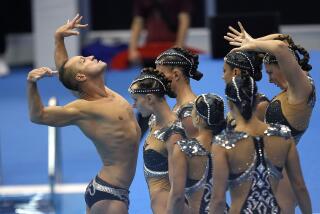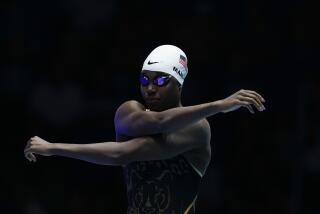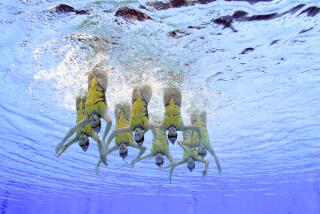‘Why We Swim’ dives into water’s transformative power
- Share via
How do you become an Icelandic legend? Try surviving six hours in 41-degree water, swimming three miles through pitch darkness toward a distant lighthouse to shore, then hiking barefoot an additional mile across jagged, icy terrain before finally finding help.
Guðlaugur Friðþórsson’s unlikely story of survival after his fishing boat capsized is among many inspiring examples of swimmers overcoming adversity thrillingly recounted in Bonnie Tsui’s new book, “Why We Swim.”
Tsui takes readers on a trip through time and around the world, recounting the myriad ways humans have endured, adapted to and interacted with water over thousands of years. Her book also is a meditation on swimming’s transformative effect on body, mind and soul. A Bay Area journalist, surfer and lifelong swimmer, Tsui joins the Los Angeles Times Book Club July 28 to talk about her work and the state of the nation’s second-most popular form of recreation, after walking.
At the heart of the book are extraordinary tales of long-distance swimmers and what drives them to brave extreme cold, vicious currents, sharks and other hazards. There is Lynne Cox, the legendary Los Alamitos athlete whose pioneering achievements include crossing the Bering Strait, swimming from Alaska to the Soviet Union in water as cold as 38 degrees. Southern California’s Diana Nyad, who at 64 became the first person to complete a swim from Cuba to Key West, makes an appearance too.
Kim Chambers, who nearly lost her leg in a fall, found a renewed sense of purpose in open water and became the first woman to swim solo from the Farallon Islands to the Golden Gate Bridge, a 30-mile journey through an area frequented by great white sharks. Chambers is one of only a handful of people who have completed the Oceans Seven challenge, which includes seven of the world’s most grueling open-water channel swims.
In trying to understand what drives these extreme athletes, Tsui concludes that distance swimming taps into something deep in the soul as well as testing the body. “What a lot of the swimmers have said is that when they are in these very, very long, arduous conditions, they’re alone with themselves in the cavern of their minds,” she says in an interview. “The nature of these long swims is they basically go on these long visits with themselves. It’s really as much a psychological journey as a physical one.”
Guðlaugur Friðþórsson was an accidental distance swimmer who found unexpected and ultimately unwanted celebrity, even chased down by producers from “The Tonight Show Starring Johnny Carson” after surviving the March 1984 accident. Dubbed “the human seal” for his unusually thick fat layer that protected him from hypothermia, the fisherman was studied by scientists, pursued by television crews and profiled by John McPhee in the New Yorker. Finally, he stopped talking to journalists, anxious to return to his quiet life in the small island town where he grew up.
Tsui decided to reach out anyway, sending him a three-page letter in English and Icelandic, befriending him over the course of a yearlong correspondence, and traveling to Iceland to meet him. She was enthralled by his personal story but also came to appreciate the Icelandic culture of public pools, which function as community gathering spaces for all ages in even the smallest towns.
“Everything is of a piece that just created this person, an extraordinary survivor and also this extraordinary symbol of Icelandic resilience,” she says.
Tsui also revisits Stone Age people who stroked through shallow lakes in what is now the Sahara Desert and describes the surprising physiological adaptations of free-diving fishing people in Southeast Asia and Japan.
She explores the ancient Japanese tradition of swimming martial arts, known as Nihon eiho, which influenced modern stroke techniques. She describes the “miniature United Nations” that bloomed in Baghdad’s Green Zone, where a U.S. Foreign Service worker named Jay Taylor taught hundreds of people to swim in the pool of Saddam Hussein’s former palace.
She tells the story of modern competitive swimming from the 1896 Athens Olympics, where competitors jumped off a boat and raced to shore, to the accomplishments of Dara Torres, the Los Angeles native who competed in five Olympics. Torres came out of retirement (for a third time) to win two final medals at the 2008 Beijing Games at 41.
Tsui says Americans could learn from countries such as Iceland and the Netherlands, where swimming is a birthright, part of the public school curriculum. Her book details the often-shameful history of public pools and beaches in this country, where women, Black families and others often were excluded, sometimes violently. Even today, she says, access to be swimming is “very spotty” for some communities, including people of color. “For the most part, if you want it, you really have to actively seek it out,” she says.
Tsui circles back to the California coast with her personal story of learning to brave the brisk waters of the San Francisco Bay, first with the classic mile-and-a-half crossing from Alcatraz to San Francisco and later at the city’s Aquatic Park, a sheltered harbor that is home to two venerable swim clubs. The swim from the Rock was a challenge, but Tsui says her breakthrough came when she finally got the courage to shed her wetsuit and plunge into the Bay in nothing but a swimsuit.
“The wetsuit thing was definitely a mental hurdle that was big, but then I saw 80-year-old Mimi, and she’s not even batting an eyelash. She just strides right into the water,” Tsui says, referring to another member of San Francisco’s bayside Dolphin Club. “The cold burns in a funny way, and then you are generating your own heat. It’s feeling acutely more alive and paradoxically being closer to death.”
“Why We Swim” is peppered with scientific findings on the health benefits of swimming, which has been shown to reduce blood pressure, decrease arterial stiffness and improve function for patients with arthritis. Tsui also is enthusiastic about the psychological benefits of an activity that has been described as “moving meditation.”
When you immerse yourself in water, Tsui says, you experience an “existential shift.” “You quite literally change the way you are in the world,” she says. “It’s not about swimming a mile or pushing yourself; it’s about a change in perspective. And don’t we need that now? Isn’t it wonderful to be able to do that?”
Book Club: If you go
Bonnie Tsui, author of “Why We Swim,” joins the L.A. Times Book Club Los Angeles Times Book Club in conversation with reporter James Rainey. Special guest: long-distance swimmer Lynne Cox.
When: 7 p.m. July 28
Where: Free virtual event free virtual event livestreaming on The Times Facebook Page. Or tune in on YouTube or Twitter. Register for the event here.
More info: latimes.com/bookclub
Bio: Bonnie Tsui
Born: 1977 (age 43), in Queens, N.Y.
Last name pronounced: TSOY
Education: Harvard University
Career: Author. Contributor to the New York Times, California Sunday magazine and other publications.
Books: “Why We Swim” (2020) and “American Chinatown: A People’s History of Five Neighborhoods” (2009) winner of the Asian/Pacific American Award for Literature
Lives: In Berkeley with her husband and two sons, 7 and 9
Twitter: @bonnietsui
Website: bonnietsui.com
More to Read
Sign up for our Book Club newsletter
Get the latest news, events and more from the Los Angeles Times Book Club, and help us get L.A. reading and talking.
You may occasionally receive promotional content from the Los Angeles Times.










